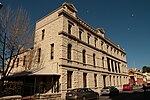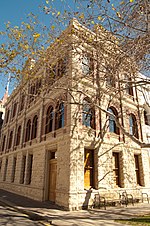HMAS Ovens
1967 shipsMuseum ships in AustraliaMuseums in Western AustraliaOberon-class submarines of the Royal Australian NavyShips built by Scotts Shipbuilding and Engineering Company ... and 2 more
Ships built on the River ClydeUse Australian English from March 2014

HMAS Ovens (S 70) is an Oberon-class submarine, formerly of the Royal Australian Navy (RAN). She was one of six Oberons built for the Royal Australian Navy by the Scottish Scotts Shipbuilding and Engineering Company, and entered service in 1969. The vessel was named for Irishman and Australian explorer John Ovens (1788–1825) and for whom the Victorian river Ovens was named. During her career, Ovens was the first RAN submarine to deploy with the ANZUK force, and the first RAN submarine to fire an armed Mark 48 torpedo, sinking the target ship Colac. The boat was decommissioned in 1995, and is preserved at the Western Australian Maritime Museum as a museum ship.
Excerpt from the Wikipedia article HMAS Ovens (License: CC BY-SA 3.0, Authors, Images).HMAS Ovens
Slip Street,
Geographical coordinates (GPS) Address External links Nearby Places Show on map
Geographical coordinates (GPS)
| Latitude | Longitude |
|---|---|
| N -32.05526 ° | E 115.73868 ° |
Address
HMAS Ovens
Slip Street
6160
Western Australia, Australia
Open on Google Maps










